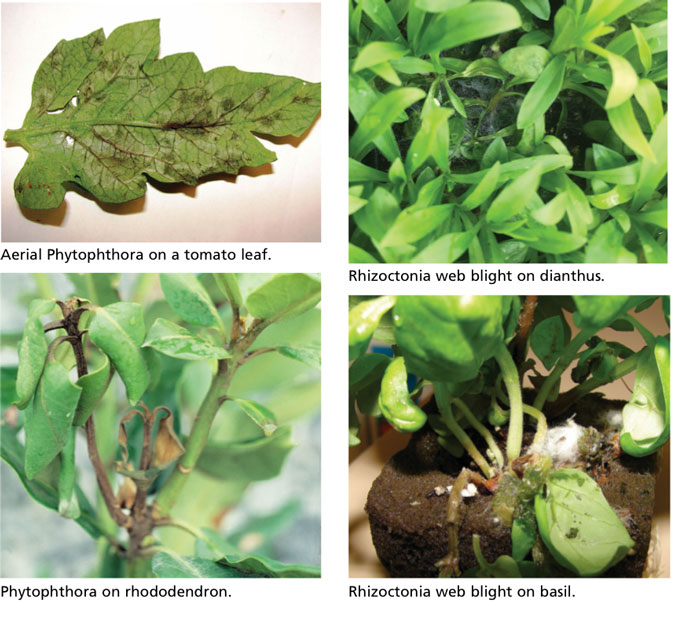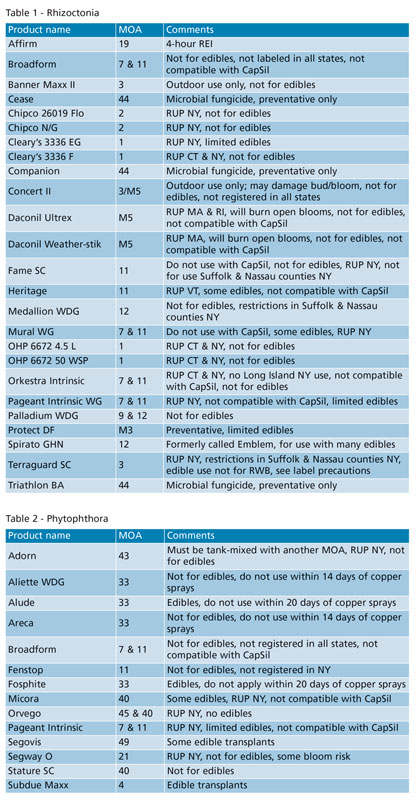2/1/2019
Blinded by the Blight
Joanne Lutz

Plants are subject to an array of foliar diseases: blights, root and stem rots, bacterial infections, wilts, viruses and nematode diseases. Symptoms that appear on afflicted plants are clues, but unless a telltale sign of the causal organism is present, identification can be challenging without microscopic examination. The same goes for pathogens affecting roots.
While symptoms may be visible above ground, the actual cause could be a soil-borne fungus. Let’s explore two root-rot pathogens—Rhizoctonia and Phytophthora—with the unique ability to infect plant foliage as an aerial blight and how to tell the difference.
Real talk about Rhizoctonia
Aerial Rhizoctonia web blight (RWB) outbreaks occur when weather is sunny, humidity is high and foliage remains wet for hours. Ideal conditions are 70 to 90F (21 to 32C) with humidity above 65%. The Rhizoctonia pathogen can cause root and crown rot, as well as stem cankers. It’s one of the two primary causes of seedling death (damping off). Rhizoctonia doesn’t produce spores, but it can produce a survival structure known as sclerotia, and it can survive in plant debris and in soil for years.
Rhizoctonia affects many plants, including aster, begonia, chrysanthemum, dianthus, ferns, gerbera, impatiens, petunia, vinca and zinnia. Many herbaceous perennials and landscape plants are prone to infection, too.
Typical infections occur when the crop canopy is dense. Often, a plant can look great from the outside, but, using your hands to gently separate foliage, you may see rotted foliage within. In other cases, symptoms are very visible. Hyphae grow into a spider web-like mat known as mycelium. This can be seen with the naked eye, growing along the soil surface or up stems onto foliage.
When in doubt, take a sample from the diseased plant material; place foliage and stems between two layers of wet, brown paper towels or moist, dark-colored newspaper pages. In both cases, the dark color enhances visibility of the mycelia, which is white. Seal the sample in a zip-top bag or salad container, and store at room temperature for 36 to 48 hours. Examine for webbing.

All about aerial Phytophthora
Phytophthora is a common root and crown pathogen of many ornamental and edible crops. Phytophthora root rot appears darker in color with less sloughing off of roots than Pythium. Stunting and wilting often occur, and crowns may break off easily at the soil line. There are more than 60 recognized Phytophthora species; at least 10 have been reported on potted plants.
Many Phytophthora species are specific to common plant genera: azalea, bacopa, calibrachoa, dogwood, gerbera, lavender, pansy, petunia, poinsettia, rhododendron, vinca, and many herbaceous perennials and vegetable crops, particularly tomato.
There are three key pathogen species: P. infestans, P. ramorum and P. parasitica. P. infestans prefers cool spring/fall weather (60 to 70F/15 to 21C days, 50 to 60F/10 to 15C nights), while the others are considered hot weather diseases.
When above-ground infections occur, known as aerial Phytophthora, plants often exhibit a rapid wilt with a characteristic bleaching of leaves starting at the leaf base. Leaf spotting, leaf drop, dull-colored isolated branches/stems or stem lesions are other pathogen indicators. On some plants (e.g., tomato), whitish sporulation can be observed under high infections, though this is somewhat uncommon.
Phytophthora belongs to the class Oomycetes, which also includes Pythium and downy mildew. The pathogen is spread by splashing water where zoospores swim to infect roots, foliage and stems. Oospores produced are the resting/survival equipment of the pathogen; they’re responsible for the random reoccurrences under certain conditions. Sanitation is the link that breaks the chain of the reinfection process.
Control options
Management of both aerial pathogens, Rhizoctonia web blight and aerial Phytophthora, includes practices to reduce humidity within the canopies of susceptible crops. Allow for adequate spacing and facilitate good air flow. Avoid late-day irrigation and saturated conditions that leave wet foliage going into the night. Both fungi are soil-borne and rely on movement through splashing and running water to spread.
While some fungicides may control both pathogens, it’s important to note that products for Phytophthora must be carefully chosen and rotated, due to reported resistance to mefenoxam (Subdue) among some Phytophthora species. To reduce further resistance, rotation with other MOA products will improve performance. For foliar aerial Rhizoctonia and aerial Phytophthora, foliar sprays are recommended.
While Tables 1 and 2 are provided as a summary, growers must read and follow the entire pesticide label. Products other than those mentioned may be safe, legal and effective. Not all products may be registered for use in all states. Contact your supplier as needed for further guidance. GT
Joanne Lutz is a GGSPro Technical Support Representative for Griffin. She can be reached at ggsprotech@griffinmail.com.